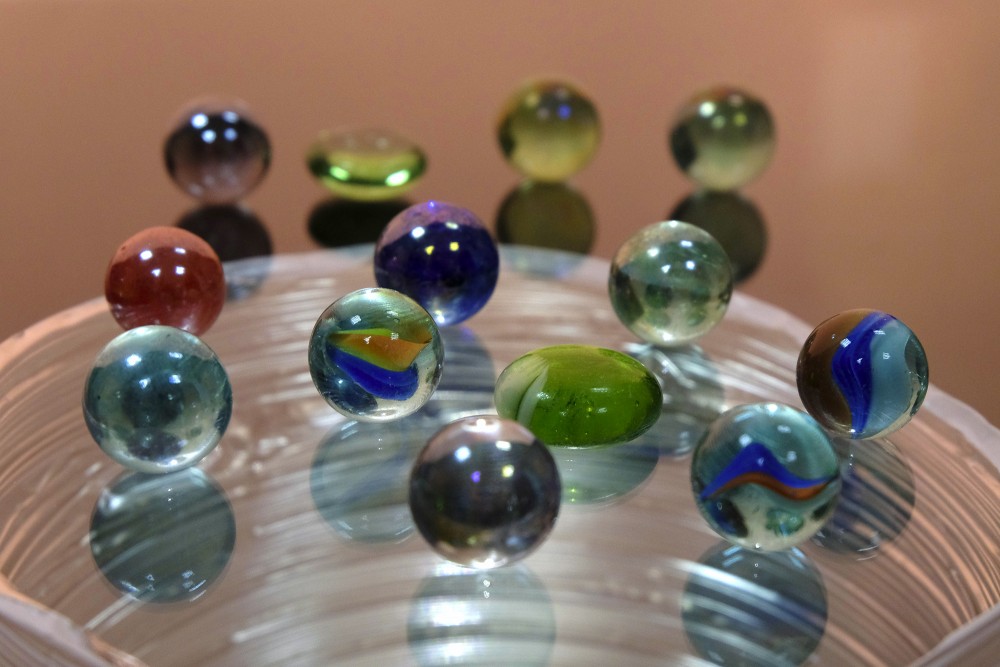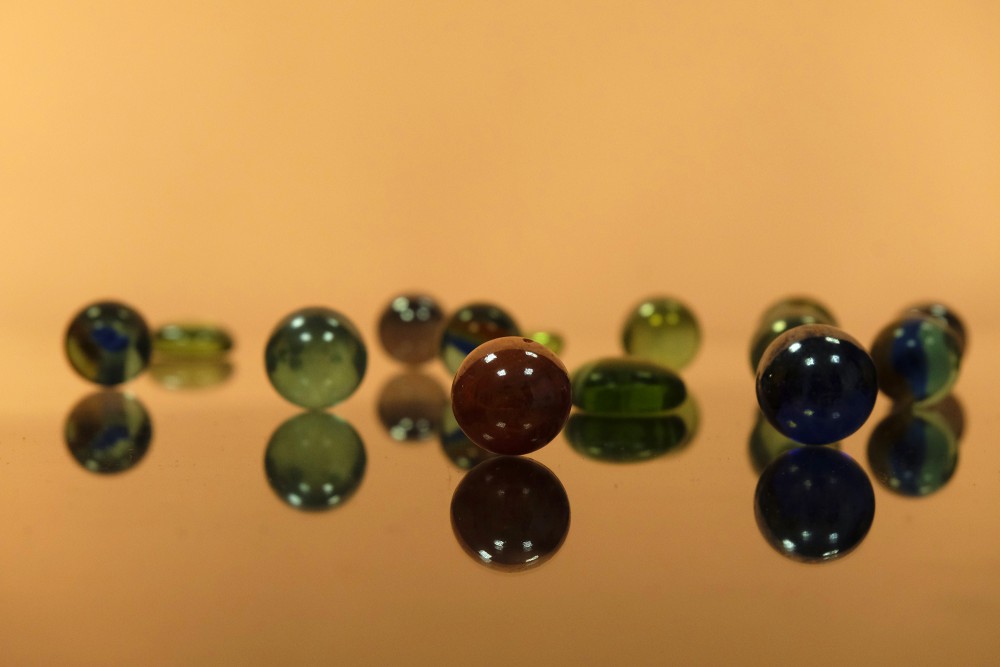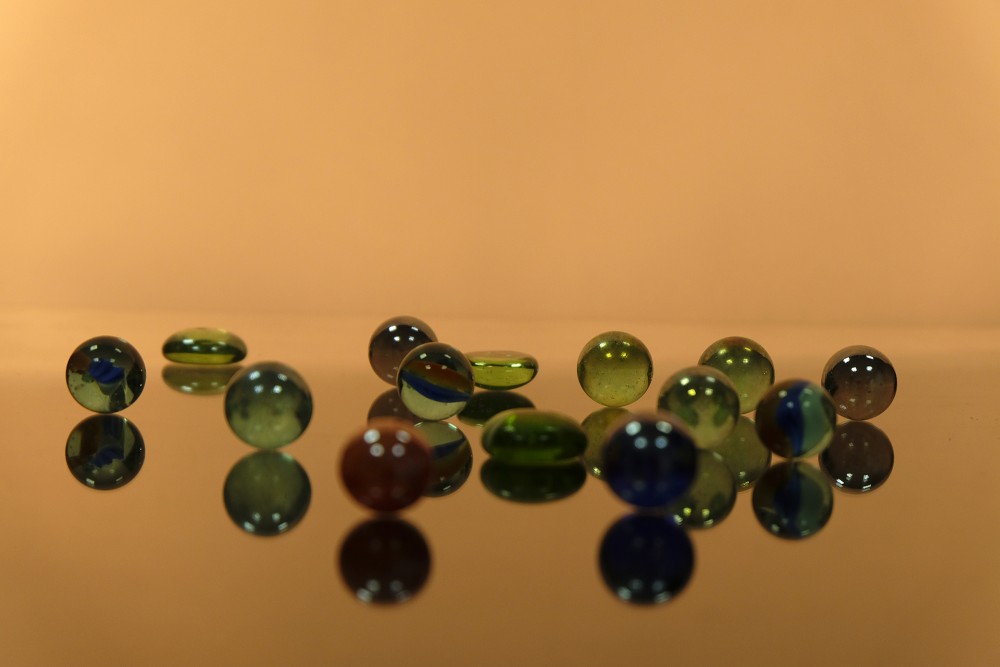Marble
A marble is a small spherical object often made from glass, clay, steel, plastic, or agate. These balls vary in size. Most commonly, they are about 13 mm (1⁄2 in) in diameter, but they may range from less than 1 mm (1⁄30 in) to over 8 cm (3 in), while some art glass marbles for display purposes are over 30 cm (12 in) wide. Marbles can be used for a variety of games called marbles. They are often collected, both for nostalgia and for their aesthetic colors. In the North of England the objects and the game are called "taws", with larger taws being called bottle washers after the use of a marble in Codd-neck bottles, which were often collected for play. These toys can be used to make marble runs, a form of art, or they can be used in marble races, a type of race using marbles.
History
In the early twentieth century, small balls of stone from about 2500 BCE, identified by archaeologists as marbles, were found by excavation near Mohenjo-daro, in a site associated with the Indus Valley civilization. Marbles are often mentioned in Roman literature, as in Ovid's poem Nux (which mentions playing the game with walnuts), and there are many examples of marbles from excavations of sites associated with Chaldeans of Mesopotamia and ancient Egypt. They were commonly made of clay, stone or glass. Marbles arrived in Britain, imported from the Low Countries, during the medieval era.
In 1503 the town council of Nuremberg, Germany, limited the playing of marble games to a meadow outside the town.
It is unknown where marbles were first manufactured.A German glassblower invented marble scissors, a device for making marbles, in 1846. Ceramic marbles entered inexpensive mass production in the 1870s.
The game has become popular throughout the US and other countries.The first mass-produced toy marbles (clay) made in the US were made in Akron, Ohio, by S. C. Dyke, in the early 1890s. Some of the first US-produced glass marbles were also made in Akron, by James Harvey Leighton. In 1903, Martin Frederick Christensen—also of Akron, Ohio—made the first machine-made glass marbles on his patented machine. His company, The M. F. Christensen & Son Co., manufactured millions of toy and industrial glass marbles until they ceased operations in 1917. The next US company to enter the glass marble market was Akro Agate. This company was started by Akronites in 1911, but located in Clarksburg, West Virginia. Today, there are only two American-based toy marble manufacturers: Jabo Vitro in Reno, Ohio, and Marble King, in Paden City, West Virginia.
Types of marbles
There are various types of marbles, and names vary from locality to locality.
- Aggie - made of agate (aggie is short for agate) or glass resembling agate, with various patterns like in the alley
- Alley or real - made of marble or alabaster (alley is short for alabaster), streaked with wavy or other patterns with exotic names like corkscrew, spiral, snake, ribbon, onyx, swirl, bumblebee, and butterfly
- Ade - strands of opaque white and color, making lemon-ade, lime-ade, orange-ade, etc.
- Cat's eye or catseye - central eye-shaped colored inserts or cores (injected inside the marble)
- Beachball - three colors and six vanes
- Devil's eye - red with yellow eye
- Red devils - same color scheme as a devil's eye but swirly.
- Clambroth - equally spaced opaque lines on a milk-white opaque base. Rare clams can have blue or black base glass. Medium-high value for antique marbles; rare base color valued much higher.
- Lutz - antique, handmade German swirl, containing bands of fine copper flakes that glitter like gold. Erroneously thought to have been invented by noted glassmaker Nicholas Lutz. Medium-high value for antique marbles, depending on specific sub-type of Lutz design.
- Oilie or oily - opaque with a rainbow, iridescent finish
- Onionskin - antique, handmade German swirl, with many closely packed surface streaks. Medium price range for antique marbles.
- Opaque - a popular marble that comes in many colors
- Oxblood - a streaky patch resembling blood
- Pearls - opaque with single color with mother of pearl finish
- Toothpaste - also known as plainsies in Canada. Wavy streaks usually with red, blue, black, white, orange.
- Turtle - wavy streaks containing green and yellow
- Bumblebee - modern, machine-made marble; mostly yellow with two black strips on each side
- China - glazed porcelain, with various patterns similar to an alley marble. Geometric patterns have low value; flowers or other identifiable objects can command high prices.
- Plaster - a form of china that is unglazed
- Commie or common - made of clay; natural color or monochrome coloration. Made in huge quantities during nineteenth and early twentieth centuries.
- Bennington - clay fired in a kiln with salt glaze—usually brown, often blue. Other colorations fairly scarce. Fairly low value.
- Crock - made from crockery (earthenware) clay
- Croton alley or jasper - glazed and unglazed china marbled with blue
- Crystal or clearie or purie - any clear colored glass - including "opals," "glimmers," "bloods," "rubies," etc. These can have any number of descriptive names such as "deep blue sea", "blue moon", "green ghost", "brass bottle", "bloody Mary".
- Princess - a tinted crystal
- Galaxy - modern, machine-made marble; lots of dots inserted to look like a sky of stars
- Indian - antique, handmade German marble; dark and opaque, usually black, with overlaid groups of color bands; usually white, and one or more other colors. Can also have many colors like blue, green and scarlet. Medium price range for antique marbles.
- Mica - antique, handmade German marble; glassy to translucent with streaks or patches of mica, ranging from clear to misty. Value depends on glass color.
- Steely - made of steel; a true steely (not just a bearing ball) was made from a flat piece of steel folded into a sphere and shows a cross where the corners all come together.
- Sulphide - antique, handmade German marble; large (3 to 8 cm [1.25 to 3 in] or more) clear glass sphere with a small statuette or figure inside. Most common are domesticated animals such as dogs, cats, cows, etc.; then wild animals; human figures are scarce; inanimate objects such as a train or pocket watch are very rare and command high prices. The interior figures are made of white clay or kaolin, and appear a silvery color due to light refraction. A sulphide with a colored-glass sphere, or with a painted figure inside, is also very rare and brings a high price. Like other types of antique marbles, sulphides have been reproduced and faked in large quantities.
- Swirly - is a common marble made out of glass with one swirly color.
- Shooter- Any marble but in a bigger size.
- Tiger- clear with orange-yellow stripes
- Baby - white with colours visible on the outside
- Tom Bowler - Large glass marble at least twice as big as a normal marble
Art marbles
Art marbles are high-quality collectible marbles arising out of the art glass movement. They are sometimes referred to as contemporary glass marbles to differentiate them from collectible antique marbles, and are spherical works of art glass.
Collectible contemporary marbles are made mostly in the United States by individual artists such as Josh Simpson.
Art marbles are usually around 50 millimetres (2.0 in) in diameter (a size also known as a "toe breaker"), but can vary, depending on the artist and the print.
Manufacturing
Marbles are made using many techniques. They can be categorized into two general types: hand-made and machine-made.
Marbles were originally made by hand. Stone or ivory marbles can be fashioned by grinding. Clay, pottery, ceramic, or porcelain marbles can be made by rolling the material into a ball, and then letting dry, or firing, and then can be left natural, painted, or glazed. Clay marbles, also known as crock marbles or commies (common), are made of slightly porous clay, traditionally from local clay or leftover earthenware ("crockery"), rolled into balls, then glazed and fired at low heat, creating an opaque imperfect sphere that is frequently sold as the poor boy's "old timey" marble. Glass marbles can be fashioned through the production of glass rods which are stacked together to form the desired pattern, cutting the rod into marble-sized pieces using marble scissors, and rounding the still-malleable glass.
One mechanical technique is dropping globules of molten glass into a groove made by two interlocking parallel screws. As the screws rotate, the marble travels along them, gradually being shaped into a sphere as it cools. Colour is added to the main batch glass and/or to additional glass streams that are combined with the main stream in a variety of ways. For example, in the "cat's-eye" style, coloured glass veins are injected into a transparent main stream. Applying more expensive coloured glass to the surface of cheaper transparent or white glass is also a common technique.
There were a lot of businesses that made marbles in Ohio.Currently, the world's largest manufacturer of playing marbles is Vacor de Mexico. Founded in 1934, the company now makes 90 percent of the world's marbles.Over 12 million are produced daily.
en.wikipedia.org
https://en.wikipedia.org/wiki/Marble_(toy)
Continue reading


